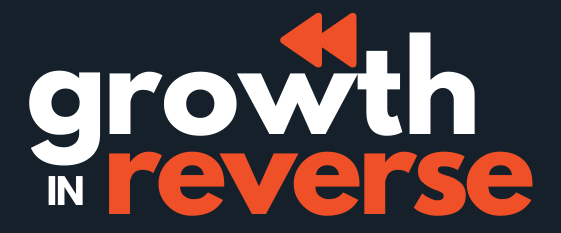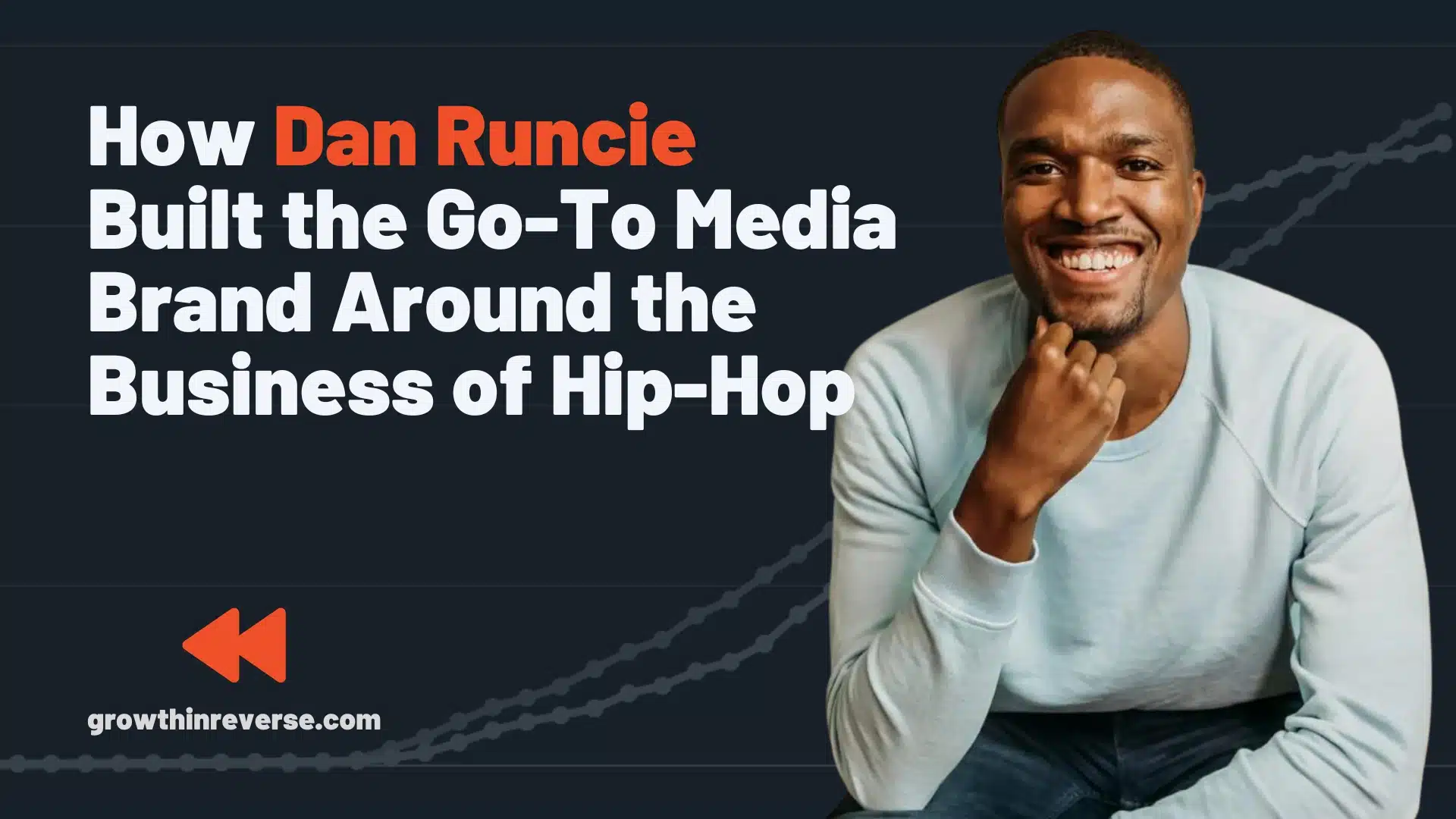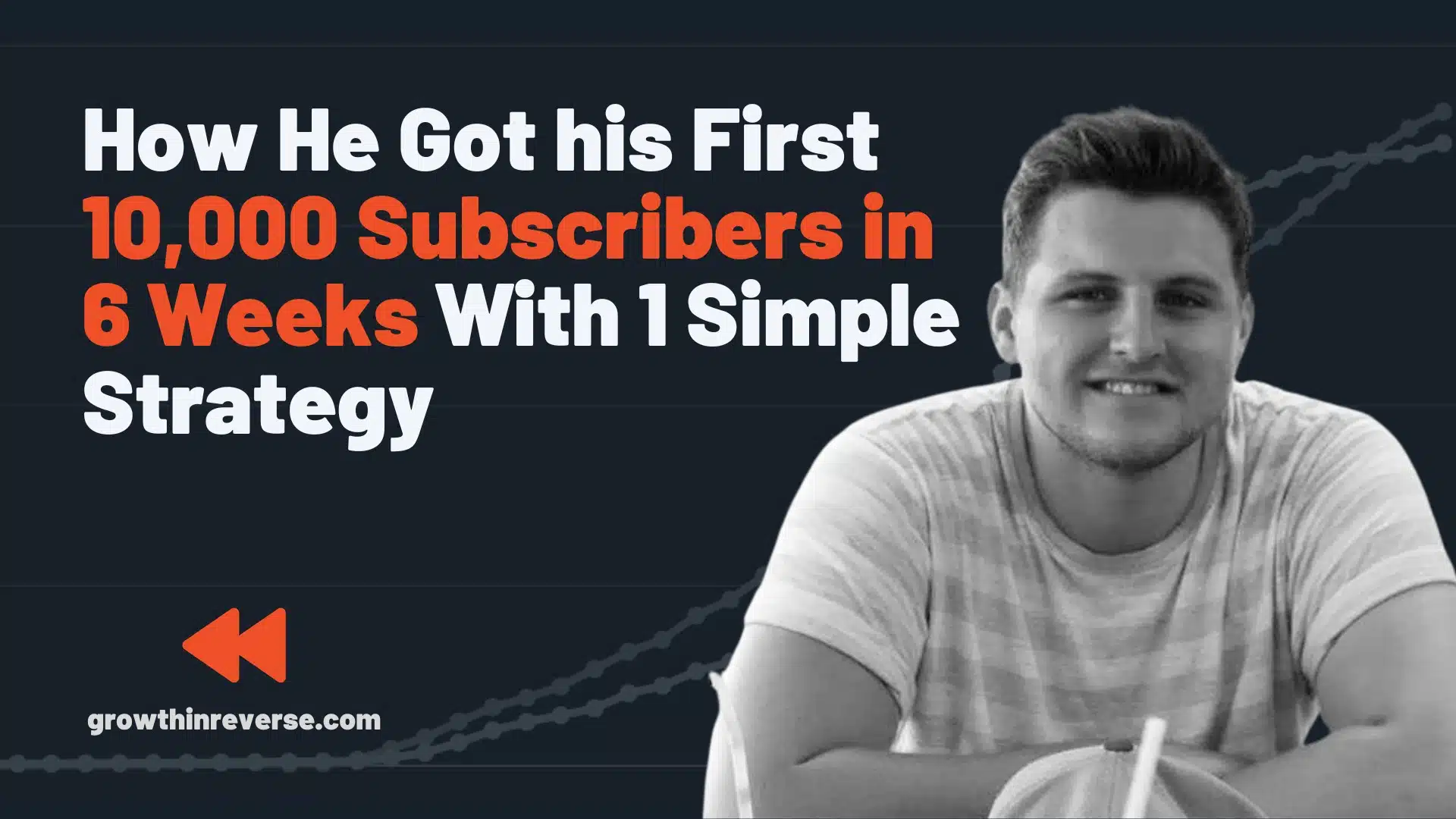How do you get almost 60k subscribers in under 3 years when you have no audience?
That’s what Ali Abouelatta has done with his incredible newsletter called First 1000.
First 1000 is kind of like these deep dives you see here, but Ali figures out how startups and companies like Uber, Doordash, Morning Brew & Spotify got their first 1000 customers.

The Growth Timeline of First 1000
The growth of First 1000 started off with a slow increase, but then it just takes off and doesn’t slow down…even to this day.
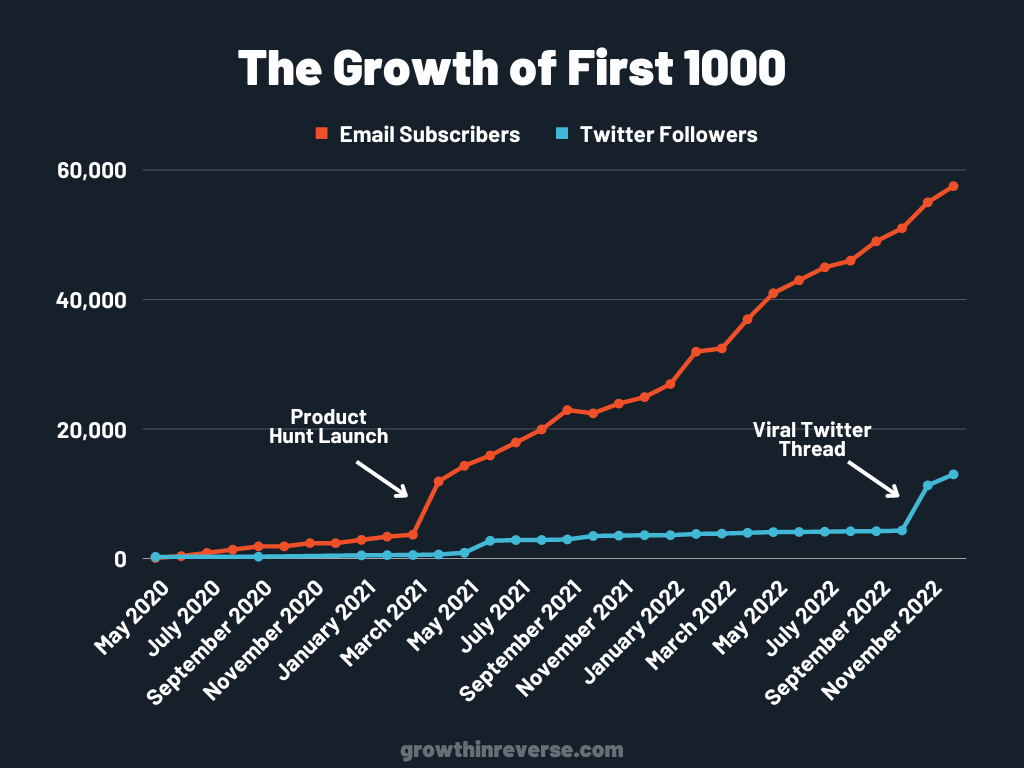
That huge increase you see was from Ali’s second Product Hunt launch. More on that below.
But different from other creators I’ve highlighted in the past, Ali didn’t grow because he had a Twitter following. In fact, when he started the newsletter, he only had around 380 followers on Twitter.
So how did he grow his newsletter so big so quickly?
The 3 Growth Levers of Ali Abouelatta
Ali has done some really smart things in order to grow him email list quite fast. But there are 3 that stand out for me:
1. Gamifying referrals. Ali has a really clever way of keeping people engaged around referring others to his content.
2. Testing and experimenting everything that might work. Ali has tried a LOT of tactics to find something that worked.
3. Collaborations and partnerships. Ali has been able to collaborate with top names in the newsletter space (cough cough, Lenny Rachitsky), and has invited others to help him write certain posts.
Let’s dig into those a bit more.
1. Gamifying Referrals
Referrals can be one of the best ways to help grow a newsletter audience. But Ali has used referrals in some of the most unique ways I’ve seen.
And he hasn’t just done one creative thing, he’s evolved from cool idea to next cool idea along the way.
Let me show you a few examples of tactics he’s tried in the past to get more referrals.
Share and Get a Gift
In the early days, Ali was offering free “rewards” if people would just simply share their post on social somewhere.
All they had to do was share it and then email him back with a screenshot of the shared post. He would then send them whatever the “prize” was at the time.
He promoted this in the “PS” line at the end of his posts.
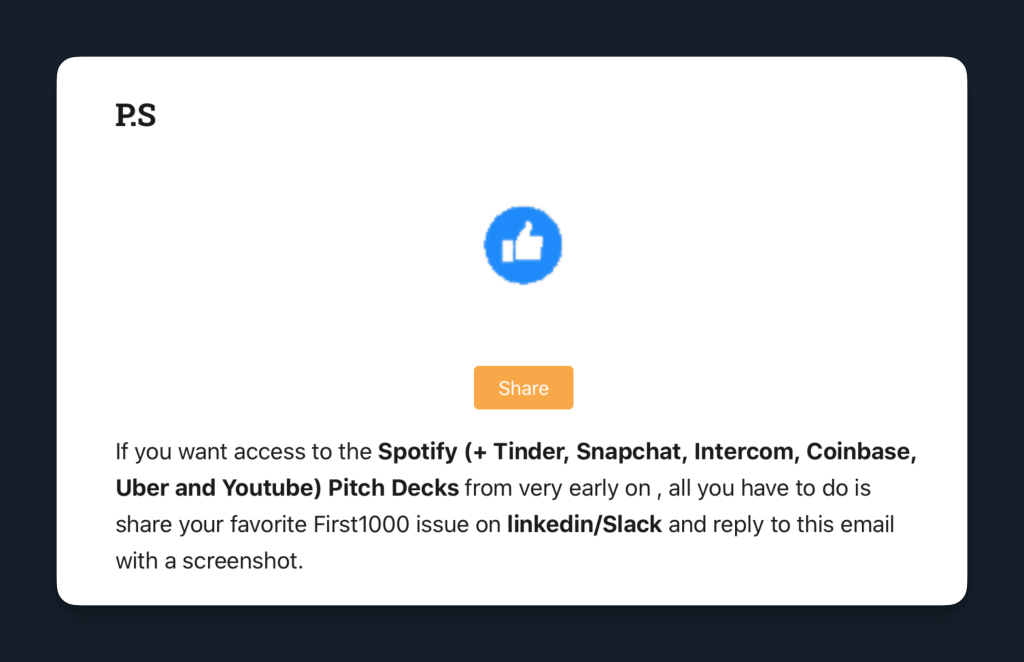
Refer People and Get Featured
He pretty quickly moved on to the next tactic of getting referrals.
If you refer enough people to the newsletter, you get a spot in the “links” list at the bottom of the newsletter.
What a scrappy way to get people to refer others to your email list.
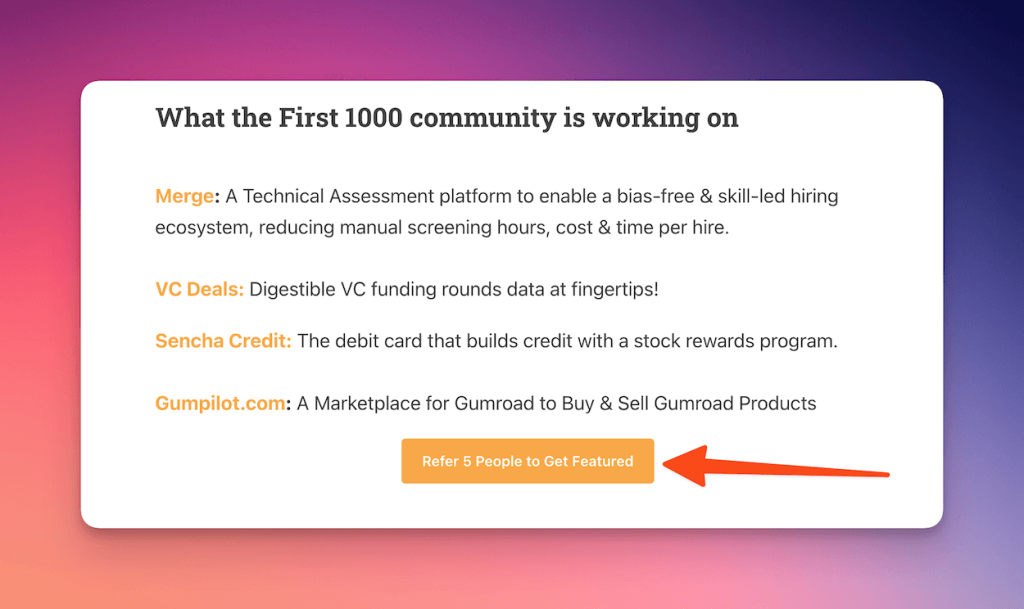
This is also a great, low-commitment way to get stats you could give to potential sponsors in the future who would be paying for these spots.
Since sponsors are going to want to know on average how many people click through those links, and what the results were on the back end, I think this is a genius way to test it out before trying to sell these spots.
He then upped the ante and required people to refer more than 10 others that month in order to get the shoutout.
And in March of 2022, he had 6 people who were able to do that.

That’s wild.
At that point, he had around 32k subscribers, so having 6 that got more than 10 is a decent amount.
A good portion of people won’t ever refer others. Plus, this doesn’t take into account the people who tried but only had 6 or 7 referrals.
He stuck with this version of a referral program from April of 2021 until this March.
This method is so simple, yet so genius, I might just have to test it out.
His Current Referral Program
In March of 2022, Ali changed his referral program to be an ever-changing referral gift.
But the crazy part is that every month your number of referrals resets. So if you want next month’s reward you have to send another X number of people.
In December of 2022, it’s currently at 25 referrals.
That’s A LOT of people for one person to refer in a single month…or is it?

At first I thought this was crazy and there was no way people could get that many every month.
But Ali has said that his top referrers have sent over 100 people, with 1 or 2 sending over 200 referrals.
That’s insane.

If you’re enjoying this, can you sign up for the First 1000 newsletter with this link? I really want to see what this little avatar does as you refer people!
I promise to share it on Twitter when it updates 🙂
Then I started seeing some YouTubers including their First1000 link in their video descriptions.
Clearly, it’s getting people to refer others.
Ali is playing on a few bets to come true which he talks about here:
- Urgency – a new reward every month will add some urgency for people to get to the milestone before it changes.
- Sunk costs – If you’ve already gotten 3-4 referrals and only need 10 for the reward, you feel like you’ve already invested time so you need to do a little more work and hit the milestone.
- People won’t get stuck. Ali’s thinking is that while it might seem harder up front, it’s easier than trying to get a cumulative 500 referrals for a mug or some random t-shirt. Going from 0 to 5 referrals is less intimidating than 50 to 500.
I’m impressed with all of these different methods he’s tried. They’re unconventional, and exactly the kind of thing that people will remember, vs a list of swag you’ll get for sending a ton of people to a newsletter.
2. Lots of Experimentation
This is going to be a far different “experimenting” section than what I highlighted in last week’s deep dive about Dru Riley.
While Dru tested his homepage for months until it was converting super well, Ali tries tons of little micro tests.
And by tons, Ali himself talks about almost 40 of them.
Reverse Engineering the Plan
When Ali started the newsletter, he had a goal to get to 1,000 subscribers in the first 6 months.
He did the math and figured out that he needed to get 6 subscribers per day to reach that goal.
He knew he could get 6 people per day even if he had to ask people manually to subscribe. But he wanted to try growth experiments to get those people faster.
He decided that on Sundays and Mondays he would try these growth experiments. And if he didn’t hit his goal for that week, he would go and do the tried and tested methods to get 40 subscribers for the week.
The Growth Experiments
Let’s look at all of the things he tried to get to 10k subscribers.
Some of these worked, and some of them failed miserably for the amount of time he ended up putting into them.
Here is the full list I’ve curated from some of his posts here and here.
| Growth Experiment | Subscribers Gained |
| 2nd Product Hunt Launch | 4250 |
| Referrals | 2034 |
| Mentions from The Diff and Replit founder | 475 |
| Cross Promotions | 465 |
| 330 | |
| SEO | 296 |
| PM Resources | 274 |
| HN Feature- Doordash | 219 |
| Hada News | 180 |
| Clubhouse Room | 170 |
| HN Feature – Slice (Guy Kawasaki shoutout) | 117 |
| MENA Investors Database | 73 |
| Joshua @ DoNotPay Retweet | 73 |
| Facebook Alma Matter University Group | 63 |
| Clubhouse Invites | 55 |
| #Intro Slack Communities | 55 |
| Screenshots | 50 |
| “Who leaves their email on twitter?” | 31 |
| Listing on every Newsletter Directory | 28 |
| Cold Emailing 1000+ founders | 27 |
| Personal Linkedin Posts | 25 |
| Reaching out to 1700+ Accelerators | 22 |
| Indie Hacker Posts | 22 |
| GrowthHackers Posts | 22 |
| News Hada – Blocked | 19 |
| Interviews | 17 |
| Free Ad credit – $450 | 17 |
| Guest Postings | 13 |
| Messaging People he knows | 12 |
| Google/Twitter Ads – $212 | 11 |
| Hacker News 27 posts | 6 |
| Giveaways on Linkedin | 6 |
| 1st Product Hunt Launch | 2 |
| Adding newsletter to email signature | 2 |
| Adding friends without their consent | 2 |
| All In Merch Store | 1 |
| Trump Tweet Archive | 0 |
| Invites to invite-only software | 0 |
| Betalist Launch | 0 |
All of these were things he tried on his journey to 10,000 subscribers. He reached 10k in March of 2021, so that means that all of this happened within an 8 month timeframe.
Product Hunt
His first Product Hunt launch was something he cobbled together in 15 minutes and he got the results of a 15 minute launch as well: 2 subscribers.
In January of 2021 when Trump got banned from Twitter, he built a “Trump Tweet Archive” tool that was essentially an updated list of all of Trumps tweets.
It got him 2 subscribers.
His second (technically third) Product Hunt launch for First 1000 was the most successful tactic to get him to 10k subscribers, but it wasn’t easy.
He learned his lesson for the second time around. He spent over 100 hours planning for that launch to make sure it went well, and was able to get over 4,000 subscribers in a matter of days with that one.

He ended up interviewing the founders of a product that went viral on Product Hunt. He said he spent hours on the phone with them and reverse engineered their strategy.
Then he started implementing his own version of that, and it worked.
But from what I’ve seen and heard, you can’t really have a successful launch on Product Hunt without having a community behind you.
Even with the best product, if you don’t have initial traction from some of your raving fans, it’s going to fall flat. Which is what he learned during that first round.
And that leads us to the next growth lever.
? 3. Collaborations and Partnerships
Also, if you look at some of the top ways he was able to bring in enough subscribers to reach 10k, a lot of them are backed by this concept of collaborating:
| 2nd Product Hunt Launch | 4250 | ? A successful launch requires a community and raving fans of yours |
| Referrals | 2034 | ? Come from other people |
| Mentions from The Diff and Replit founder | 475 | ? Mentions from other creators |
| Cross Promotions | 465 | ? Other creators promoting his newsletter and vice versa |
| 330 | ? Engaging with people | |
| SEO | 296 | |
| PM Resources | 274 | |
| HN Feature- Doordash | 219 | |
| Hada News | 180 | |
| Clubhouse Room | 170 | ? He was friendly with the co-creator of Clubhouse, and was able to get in front of his audience |
| HN Feature – Slice (Guy Kawasaki shoutout) | 117 | ? Mention from big name in the business space |
I think it’s safe to say that a lot of his subscribers have come from collaborations and just engaging with other creators.
A more recent example of him using collaborations happened in October of 2021, when Ali published a guest article on Lenny’s newsletter.
At the time Ali wrote that post, Lenny had around 90k subscribers, which is still great audience to get in front of.
Lenny has over 300k subscribers at the time of this writing. That’s not a typo.
Having a relationship with someone that influential in the space will surely pay off for him again at some point.
How You Can Use Some of Ali’s Methods
I know that was a lot, but let’s break down how you can take some of the ways Ali has seen success so you can grow your own audience.
? Engage with Other Creators and Newsletter Builders
The creator space is not a zero sum game, and that’s why I love it so much.
People are building in public, and sharing what’s working for them. They’re also open to collaborating with each other.
Put yourself out there into some creator communities and I bet you’re going to come out of it with a new friend or two that you can collaborate with.
Some ideas for places to start:
- Indie Hackers
- Facebook groups
- Slack communities
- Telegram groups
? Start a Referral Program
While there are tons of software’s you can use to setup a referral program, Ali’s made it so clear that you can start simple.
You don’t need to spend money every month for a software when you have a small audience. Eventually, as you start growing and making money from your newsletter, you can start incorporating some more robust options.
Have people tag you on social media in their posts and you can just DM them the gift, or referral bonus.
Or, you can have people manually email you a screenshot of them sharing your newsletter.
I like this second option better because you’re also slightly improving your deliverability by getting people to reply to your emails.
It doesn’t matter what you start with, you can always improve and iterate on the process as time goes.
? Try a Wide Variety of Experiments
A lot of the things Ali tried didn’t work. But that doesn’t mean they don’t work for everyone.
While he saw minimal success posting on Indie Hackers (around 22 subscribers), others like Anne-Laure Le Cunff have probably seen hundreds of subscribers from there.
While I love that he was just trying tons of things, you might have better luck cutting the list in half and spending more time on each one.
Other ones, like going live on Clubhouse probably aren’t going to work for you.
For one, Clubhouse is a dying platform, and two, he went live with one of the founders of Clubhouse. That’s not an easy feat to replicate.
I’m going to start trying out experiments and sharing the results with you guys as I see what’s working.
Are there any experiments on here you’re going to try out?
